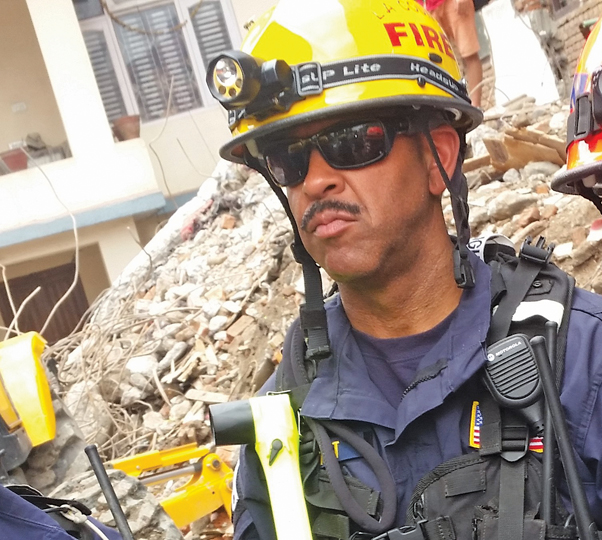Maj. Glenn ‘Tony’ Wright, 452nd Aerospace Medicine Squadron, March Air Reserve Base, recently returned from a deployment to Nepal. Although he departed from March Field, he was not in military status. Wright is an engineer, and an Urban Search and Rescue Specialist (USAR) for the Los Angeles County Fire Department’s (LACoFD) California Task Force 2 (CA-TF2), one of only two international USAR teams deployable from the U.S.
“I received the phone alert about 8 o’clock on Saturday of the April UTA,” Wright said. “I had already arranged to reschedule Sunday, so I was available to respond.”
During the team’s prior deployments to Japan, Haiti, New Zealand and other places, Wright said his military obligations prevented him from going. As his squadron’s medical readiness officer, Wright is responsible for ensuring the readiness of his members.
With 33 years of military experience, some of which was as an enlisted security policeman and a KC-135 boom operator, this citizen Airman is no stranger to rearranging schedules and getting things done.
He left the base after his Saturday drill on April 25, 2015 at 6 p.m. and proceeded directly to the LACoFD USAR headquarters in Pacoima, California, where he and the rest of CA-TF2 members bedded down for the night. By 5 a.m. Sunday morning they had received their official orders and from that point on things moved quickly, Wright said.
“We typically have most of our rescue equipment loaded on pallets in order to expedite our departure.”
They left Pacoima at noon and headed to March Field, their designated initial point of departure, to board a C-17 Globemaster III with their equipment, bound for the earthquake-stricken country of Nepal.
“We departed March as a medium rescue team of 57 members about 9 p.m. on Sunday,” Wright said. “Our route included stops in South Carolina, Ramstein (Air Base, Germany), then directly to Katmandu Airport in Nepal.”
Upon their arrival in Nepal, they were prepared to immediately conduct rescue operations, but followed the directions of the United States Office of International Development (USAID) by establishing communication with their teammates from Fairfax County Fire Department (FFCoFD), Virginia, to establish search and reconnaissance sectors with other responding nations, Wright said.
There were more than 77 USAR teams deployed to the region and many of those teams were not officially sanctioned by their host nations, so one of the main functions of CA-TF2 was to verify the search finding of other teams, Wright said.
“We conducted numerous search operations within the first few days,” Wright said. “However, we discovered and ultimately rescued our first victim on the fourth day, a 15-year-old young man.”
Unfortunately, due to the magnitude of the earthquake coupled with building standards in the country, it would be more than two weeks before they had another live rescue.
The most dramatic part of the deployment for Wright was when the second earthquake, a 7.3 magnitude, hit on May 13 at approximately 12:30 p.m. He admitted to never having been in a quake that strong and being a little scared.
“The teams had already packed all of our rescue equipment and we were in the process of demobilization,” Wright said. “Immediately after the second quake, we went back into rescue mode. We were responsible for rescuing several people who were trapped and treating (their) injuries.”
In addition to being an engineer, USAR and firefighter/paramedic with the LACoFD, Wright is also a hazardous material technician, medical specialist and rescue specialist with CA-TF2.
Wright is the best example of a citizen Airman serving with integrity, putting service before self, and providing excellence in everything he does.




